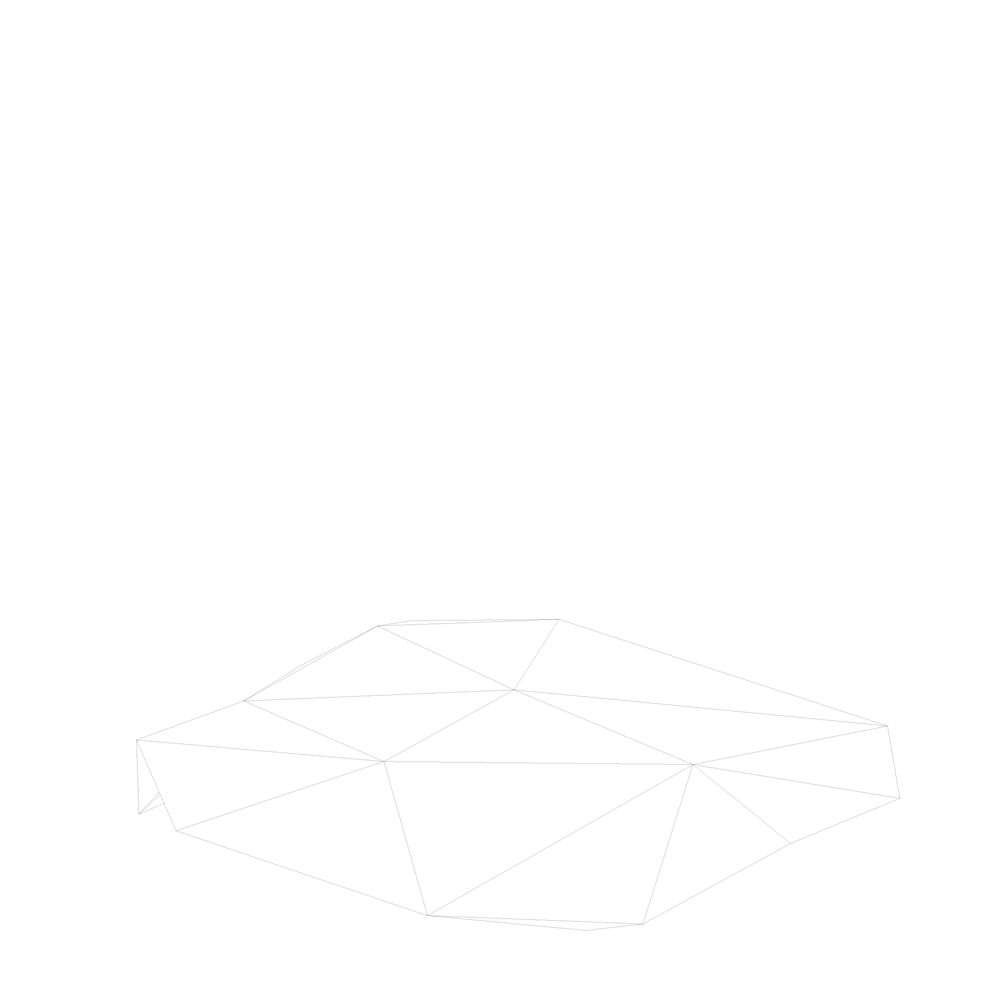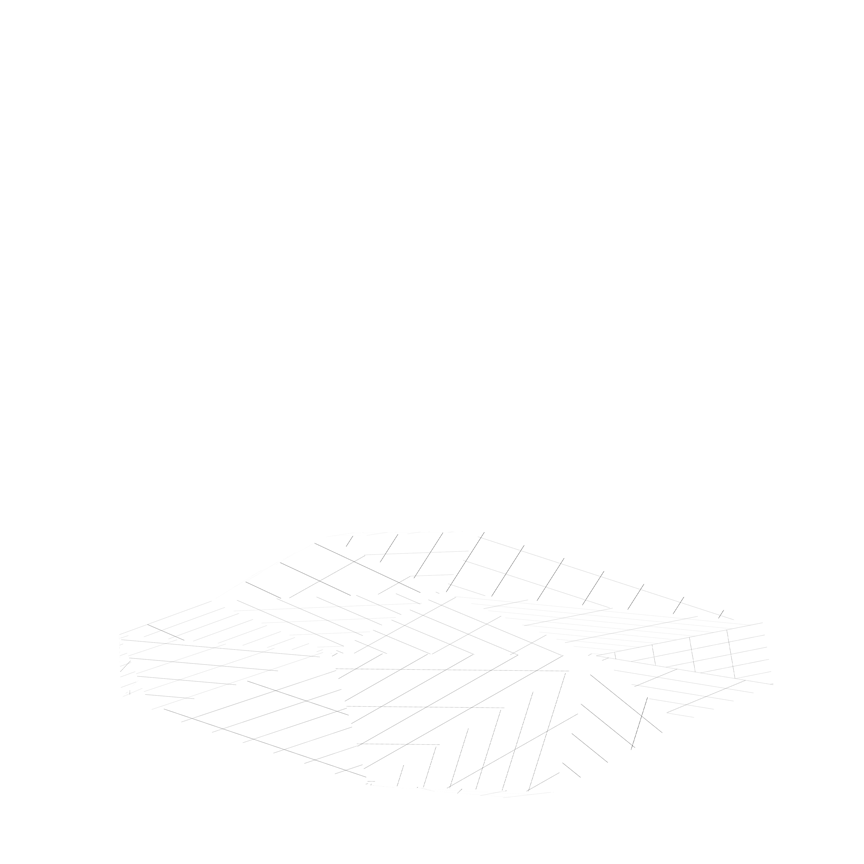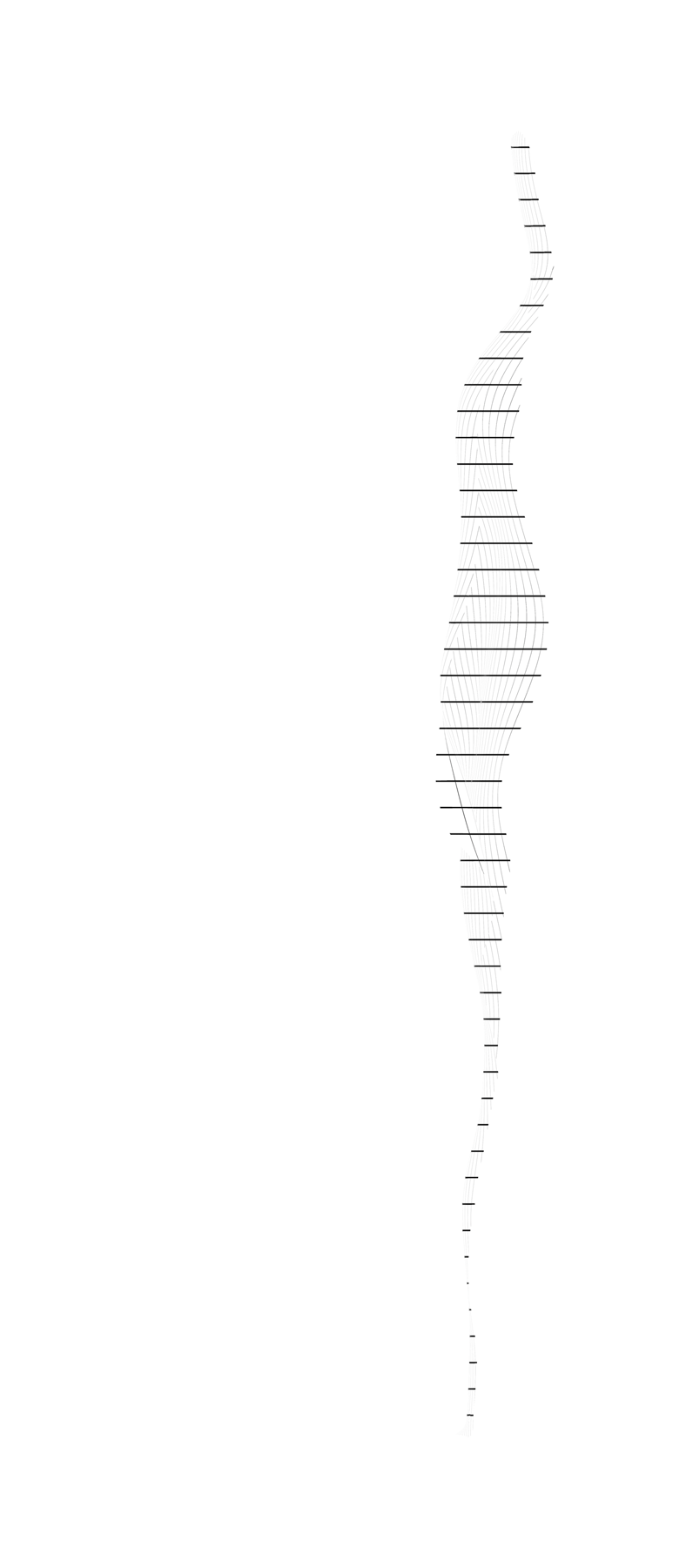
The first group of drawings revolve around the photography of Robert Longo - particularly this image of Janet, from Longo’s work on Men in the Cities. Longo represents his model as performing a near-impossible stance. The posture is fleeting: we know that the captured image is of an instant. With his photograph, Longo creates a space that allows for the preservation of the ephemeral, imposing stasis on his subject without detracting from the sense of movement that makes the image exciting. It is hard to look at without holding your breath. The model arches her back opposite to the camera, shifting her weight to her right foot while balancing with her left. This moment is heightened by the perspective and angle of the camera. In the most abstract and distilled way, I have attempted to construct the moments leading up to this image. The figure in the animation undulates unhurriedly backwards. It does not anticipate its point of arrival, but when it arrives, it holds its position, offering a moment to reflect on the way the square grid surface accommodates both the fluidity of its movement and also the containment of its form.
Robert Longo
Activation of the surface begins in a slightly forward stance. After completing a 15-degree rotation of the torso back against the reference line of the waist, the surface continues to arch backwards another 45 degrees from center. This motion is offset by the sweeping of the left leg forward at the waist, and the relative opposite at the knee – completing a near 23-degree rotation. This operation may be understood as a collection of moments which in aggregate produce the final posture.
_longo_top.grid
It is in this final posture that we see a kind of resistance to further movement in the same direction, which emphasizes the function of the surface as a boundary between the figure’s form and its position in space. To go beyond the limits of this boundary might distort the relationship between form and space that this surface seeks to explore and define.
_longo_side.grid
As with the previous exercises in plaster, this construct is best understood through its more generalized moments. To achieve these qualities, we must reduce the surface to a collection of no more than 30-or-so individual surfaces. The lines in these drawing represent the edges of each surface as they transform near-instantly to produce an aggregate of unexpectedly dissimilar forms. Rather than emphasizing the reference lines of the waist and the knee, as seen in the previous animation, the lines of the surface in this animation distribute the expression of movement democratically throughout the figure. Even as the sharp geometric shapes of the surfaces abstract the figure from its referent, the flickering of the edges of these surfaces seems to shine a light on the often invisible operators that work to produce movement in the human form.
_longo_top.reduced
When these drawings are compiled, the result is a layered diagram which isolates individual moments within the event, shifting the focus from the figure to the space it occupies These moments tell us how the body transforms the space around it as the boundary of the surface is activated. In this instance, we might ascertain that the bulk of the figure’s work is being performed in the torso, which is represented through much larger swaths of space that the movement of the torso has disturbed. However, what is less immediately apparent is the space that has been troubled by the shifting of the back leg.
_longo_side.reduced
We may take this analysis a step further by applying a materialized grid upon the reduced surface. The rendering of this animation is more chaotic than the last, due, in part, to the absence of pronounced edges. The quilt-like patterning suggests a secondary grain to each individual surface, and as the figure turns, the information appears to transfer from one surface to another, forming a complex network of communication The tighter the grid is on a surface; the more work being represented. While the looser the grid; the more generalized the construct has become in those moments.
_longo_top.material.1
Using this information, it becomes interesting to view the surfaces in aggregate from the top down. While we might presume the impressions and accompanying work to be symmetrical, in reality the constructs are highly irregular and often preference a single side. In this drawing, we see that the right side of the impression has become more generalized as it attempts to adapt to the changing conditions of the sweeping leg. Just as well, you might notice that as the surface bends backwards, the waist becomes increasingly information-dense and fraught with near-unintelligible angles.
_longo_side.material
_top.aggregate.reduced
_top.aggregate.material
Using this information, it becomes interesting to view the surfaces in aggregate from the top down. While we might presume the impressions and accompanying work to be symmetrical, in reality the constructs are highly irregular and often preference a single side. In this drawing, we see that the right side of the impression has become more generalized as it attempts to adapt to the changing conditions of the sweeping leg. Just as well, you might notice that as the surface bends backwards, the waist becomes increasingly information-dense and fraught with near-unintelligible angles. The final animation in this set is a collection of the top-down images from the two previous analyses. Within these two constructs, it is readily apparent the amount of work being performed at the waist through the densification of lines. Also notable is the directionality of lines within the upper half of the torso, which reveal the vectorized nature and momentum of the final posture in space.
The second image for reference is a collage by David Hockey of a Sunday Morning at the Mayflower Hotel. In the collage, Hockey rests on his bed centered within the middle of the room. He sits, panning from side-to-side, up-and-down, scanning and collecting images of the room for collage. His image is just recognizable as a reflection in the mirror opposite the bed. The surface between Hockey and the space he occupies is articulated with both a twisting and bending motion.
David Hockney
Activation of the surface this time finds its origin in the neutral impression generated by the tool. Deformation of the construct begins with a twisting motion 30-degrees opposite of center, and an accompanying rotation of the torso backwards at the waist of 15-degrees.
_hockney_top.grid
can you spot the corrupted frames?
The motion repeats itself in the opposite direction to produce the totalizing gesture required to produce the collage.
_hockney_side.grid
look closely
The edgeless grid surfaces in this instance define themselves primarily through the directionality of the shoulders. As the bed serves to anchor Hockney’s work, the feet serve to anchor the figure in this animation.
_hockney_top.reduced
In the reproduction of events which lead to the fabrication of this collage, it is apparent how the back becomes generalized into one or several large swaths of uninterrupted space, while the finer, more condensed moments of the waist and shoulders are defining the surfaces orientation in space.
_hockney_side.reduced
In the collection and subsequent layering of these drawings, this relationship becomes heightened through the calling out of key moments. The back begins to dematerialize as it is twisted against the right or left axis, and the hips become and extension of these surfaces as it brought in and out of alignment. This relationship becomes even more apparent when viewing the organization and directionality of the interior grain. Despite the uniform nature of motion from one side to the other, there is an obvious preference of the left portion of the construct, particularly the left shoulder, in defining the overall impact of the surface on its surroundings.
_hockney_top.material
This is best demonstrated by comparing either extremes of the motion against one another in aggregate. By calling out both moments simultaneously, the forward directionality of the left side of either form is revealed. Interestingly enough, the right side of the surface in either case is orientated in the opposite direction. These properties are undoubtedly a result of the characteristics produced by the generation of the original impression with the surface tool.
_hockney_side.material
_top.aggregate.reduced
_top.aggregate.material
Again, by comparing the top-down views of either iteration, we are able to obtain a clearer understanding of the key components in this motion. Regardless of which direction the construct is twisting, the densification of lines at the waist reveal the importance of the stationary axis in articulating form. This quality is heightened through the fleeting outer edges produced as the surface twists to the right. Juxtapose this with the consistent re-layering of the left field, and the dissymmetry becomes the most outstanding quality of the event.
The final reference image is by fashion photographer Deborah Turbeville. In it, we see a ballerina captured in a moment of stasis, collaged next to some variant of palatial architecture. In this image, the ballerina balances on the tips of her toes while using her arms to counterbalance the posture. In order to better understand the implied space of the arms gesturing away from the body, I utilize an impression taken in profile.
Deborah Turbeville
As the arm moves away from the body, the surface is stretched to accommodate the changing form. Unlike Longo’s precarious Janet, the ballerina in Turbeville’s photograph appears to hold her pose effortlessly, implying the possibility of permanence in the position she maintains. However, the stretching of the surface of this animation communicates a tension that reveals the moment to be equally ephemeral. Though the movement of the figure is fluid and controlled, the extension of the lines of the surface anticipate the figure’s inevitable and necessary departure from the pose.
_turbeville_top.grid
Within the context of the motion, the arm is swung out incrementally to 60-degrees, while the torso bends inwards 30-degrees. Rather than adding new material, as the arms gestures outwards, the surface is stretched and deformed to produce a form which in many ways resembles the fabric adorning the ballerinas shoulders, emphasizing the delicacy of the thin surface and the dynamic power of the figure it resists and holds in space
_hockney_side.grid
When viewing the reduced edges of this construct, this stretching motion is readily understood through the unfolding motion of the surface across the arm in motion. There are moments in this animation when the figure abstracts itself almost entirely from the human form. Rather than recalling the subtle operations of fine musculature, the surface seems to open and close like a piece of origami, drawing attention to its suddenly paper-like, precise, and fragile materiality. The density of the material in this moment remains relatively unchanged as the geometry of the surface is warped to produce its final positioning, only to fold in on itself again in return to its origin. Perhaps, in its seeming focus on the boundary between space and physical artifact and its suggestion of the materiality of surface, this animation demonstrates the precariousness of the relationship between space and the human form.
_hockney_top.reduced
The layering of these drawings reveals much the same information. The forward-edges of the construct remain information-dense throughout and remain relatively unchanged when compared to the stretched nature of the material enveloping the arm on the left. As the top portion of the surface leans back in response to arm’s motion, the head and shoulders unfold to become an extension of limb, rather than the torso or waist as seen previously.
_hockney_side.reduced
When viewing the finer grain of this construct, it is worth noting the density of information on the interior of the surface. Juxtaposed with the sparse nature of grain on the exterior of the enveloped limb, the strain within interior of the construct as it is stretched is revealed. Not only does the top portion of the surface become an extension of the arm, but the interior of the torso also becomes an expression of the of a gesture which so extremely extends beyond its original bounding conditions.
_hockney_top.material
This relationship is more closely revealed through the expression of the surface in aggregate from the top-down. The space between the arm and torso is unchanging in directionality and density. The interior of the construct does not retain this steadfast nature, but instead is shown to be everchanging in both qualities.
_hockney_side.material
_top.aggregate.reduced
_top.aggregate.material
Finally, through the viewing of both top-down animations together, we may better understand the permanence of the interior edge against the ever-shifting nature of the space generated between the torso and the arm. The density and repetition of lines on the exterior of the construct provide a necessary boundary against which the form is able to adapt and change while still remaining legible.
For my closing remarks - I would like to say that I hope this work is able to spark a dialogue regarding the consequence of human form within the built environment, or more generally any condition catered to the human disposition. What we know as the occupant is an enigmatic and often over-generalized character, the nuance of which is vast and ever-changing. Moving forward, it is my wish that through technological advancement, we as architects might be able to design and adapt to this less rigid model of occupation, as well as discover new ways of defining what it means to inhabit space.



























